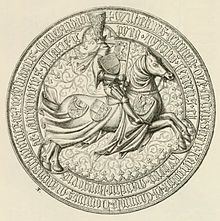Name William, of | ||
 | ||
Spouse Joanna II of Naples (m. 1401) Parents Viridis Visconti, Leopold III, Duke of Austria Grandparents Albert II, Duke of Austria, Bernabo Visconti, Beatrice Regina della Scala, Joanna of Pfirt Similar People Leopold III - Duke of Austria, Ernest - Duke of Austria, Frederick IV - Duke of Austria, Joanna II of Naples, Bernabo Visconti | ||
Great-grandparents Albert I of Germany | ||
William (c. 1370 – 15 July 1406), known as William the Courteous (German: der Freundliche), a member of the House of Habsburg, was Duke of Austria from 1386. As head of the Leopoldian line, he ruled over the Inner Austrian duchies of Carinthia, Styria and Carniola as well as the County of Tyrol and Further Austria from 1396 until his death.
Life
Born in Vienna, William was the oldest son of Duke Leopold III of Austria (1351–1386) and his consort Viridis Visconti (1352–1414), a daughter of Lord Bernabò of Milan. Leopold III had already acted as regent over the Tyrol and the Further Austrian possessions in Swabia; in 1379 he signed the Treaty of Neuberg with his elder brother Duke Albert III, whereupon he also received the Inner Austrian lands.
At the age of 14, William was betrothed to the Anjou princess Hedwig (Jadwiga; 1373–1399), the youngest daughter of King Louis I of Hungary, who had also become King of Poland in 1370. This was one of the first attempts of the Habsburgs to extend their dominions by marrying heiresses, as Louis intended his elder daughter Mary and her fiancé Sigismund of Luxembourg to succeed in Poland, while Jadwiga was designated heir to the Kingdom of Hungary. When King Louis died in 1382, Mary succeeded in Hungary. However, the Polish nobles rejected Mary and Sigismund, and instead chose Jadwiga as queen regnant. They also repudiated her betrothal to William and enforced the break-up of the engagement.
In 1386, Leopold III was killed in the Battle of Sempach. William and his brother Leopold IV succeeded him as Duke of Austria, ruling jointly with their uncle Albert III. A fierce inheritance dispute arose when Duke Albert III died in 1395 and was succeeded by his only son Albert IV, William's first cousin. An agreement was reached in the following year, based on the 1379 Treaty of Neuberg, whereupon William left the rule over Austria proper to Albert IV and, as eldest members of the Habsburg Leopoldian line, went on to rule over the three Inner Austrian duchies and the County of Tyrol taking his residence in Graz.
In 1401, William married another presumptive heiress, Princess Joanna of Naples, Hedwig's cousin and also of Angevin descent. The marriage did not produce any offspring and William did not live to see his wife succeed her brother Ladislaus of Naples as Queen Joanna II in 1414.
In 1404, his cousin Albert IV died, leaving the lands of the elder Albertinian line to his seven-year-old son Duke Albert V. William acted as an Austrian regent and again tried to take the Albertinian territories from his minor nephew, but did not succeed before his death.
William died in 1406 without heirs in Vienna. He is buried in the Ducal Crypt in Vienna's St. Stephen's Cathedral. Upon his death, another division of the Habsburg hereditary lands took place, whereafter William's brother Leopold IV took over the regency in Austria proper, the third-born Ernest the Iron inherited the Inner Austrian duchies, and Frederick IV, the youngest, Tyrol and Further Austria.
